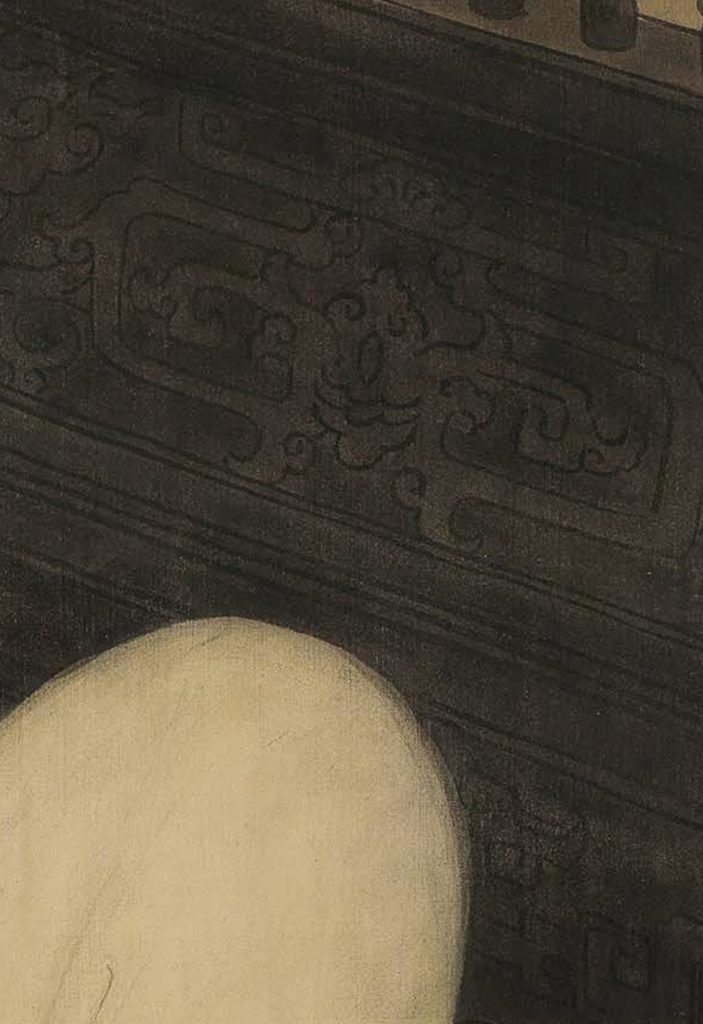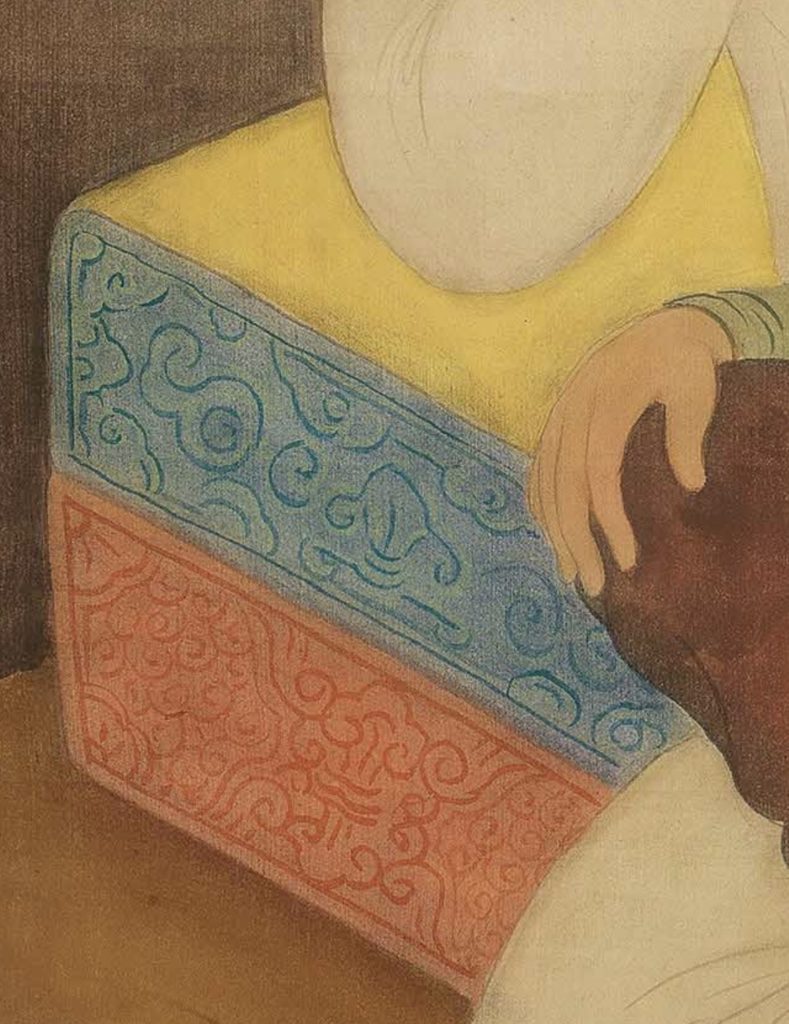Mai Thu, 1946, “Mother and children” or the “delicate manifestation” – is it really that delicate ?
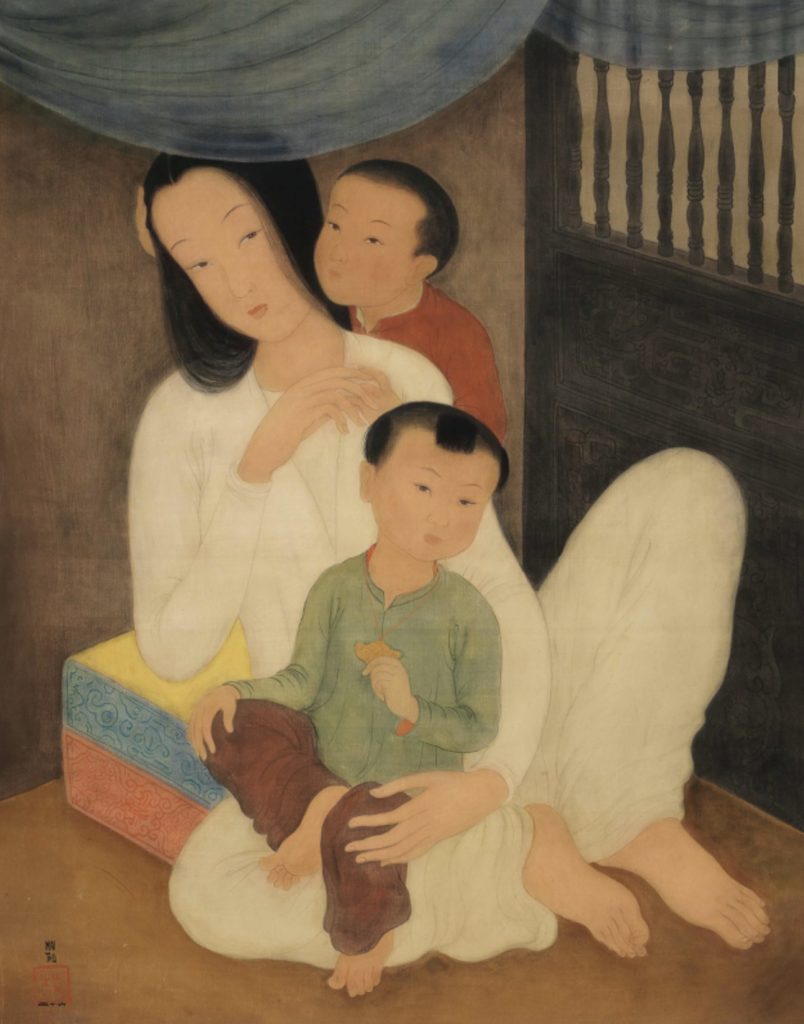
In 1960, French art critic Maximilien Gautier (1893-1977), proposed – in a booklet published by Mai Thu’s dealer Jean-François Apestéguy – his analysis of the painter’s pictorial technique.
For him, the artist was inspired by six principles formulated by “a 6th-century Chinese portraitist“, himself influenced by a long line of predecessors.
The 6 principles?
- Capture the vital rhythm
- Restore the essential structure of the line
- Submit to the necessity of resemblance
- Careful handling of color and ink
- Pay particular attention to composition and the role of space
- Take advantage of copying the old to create new possibilities.
Maximilien Gautier adds that Mai Thu’s paintings are the “delicate manifestation” of these principles.
So be it…
But what about the reality of these principles, and do they really apply to Mai Thu?
The principles:
François Cheng’s work – precisely a passage from his Souffle–Esprit (Paris 1989, p19), a fascinating and difficult work, but a delight to read – enables us to identify the “portraitist” evoked by Maximilien Gautier. We’re talking about Xie He, a painter but also an art critic who lived in China in the 6th century CE, best known for his Six Principles of Chinese Painting (绘画六法, Huìhuà Liùfǎ), presented in the preface to his book The Estimation of Ancient Paintings (古画品录, Gǔhuà Pǐnlù).
Laurence Binyon (1869-1943) noted as far back as the early 20th century (Binyon uses the term “canon” for “principle“) that:
“The first of the Canons is the only important one, for the others are concerned rather with the means intended to achieve the end defined by the first” (Introduction to Chinese and Japanese Painting… (“The Flight of the dragon“)) Translated from the English by Henri d’Ardenne de Tizac (1877-1932) First edition: Bulletin de l’amicale franco-chinoise, 1912.
This work by Shitao (1642-1707), for example, “Pines, Rocks and Waterfall“, an ink on paper (99 × 47.5 cm), condenses well, 11 centuries later, Xie He’s 6 principles:
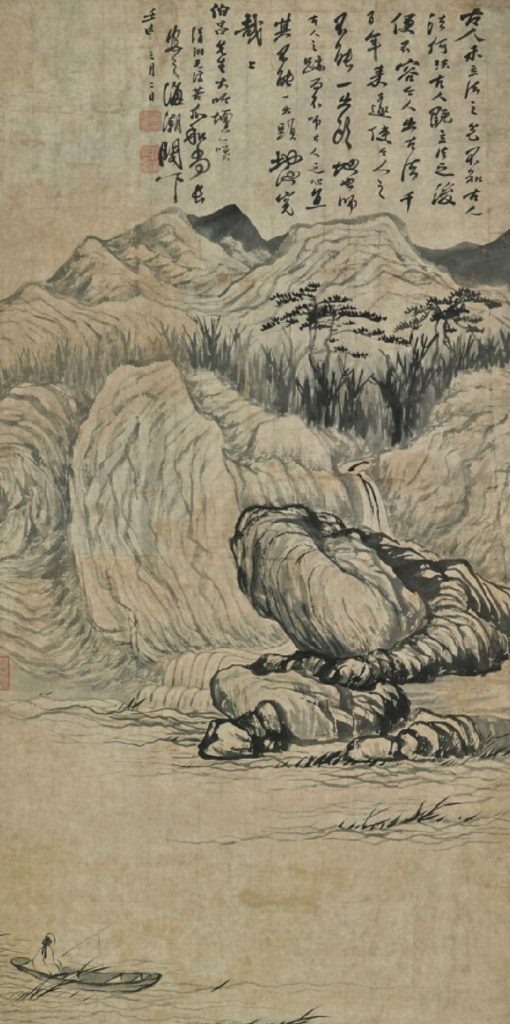
Of course, to identify the first of these, “vital rhythm”, you have to adhere to the Taoist concept on which it is based, but the other 5 are obvious to the objective eye, and the 6th requires a good knowledge of Chinese painting…
But are these same principles present in Mai Thu’s work?
Better still: does their specificity suit him?
Let’s take another look:
The “vital rhythm”?
Mai Thu, like any ambitious painter, has the ambition (almost the mental necessity) to represent one’s world. But, among all the artists he’s been meeting in Paris for the past 9 years, who’s been rubbing shoulders with Taoist cosmology (François Cheng, ibid, pp 147-149 )? Who evoked it at the Hanoi School of Fine Arts during his schooling in 1925-30? Who since?
No one.
We can also imagine the painter’s care in seeking inspiration from the ancients and using them as models. But which elders and which models if not Westerners, those Westerners whom Mai Thu, after Vu Cao Dam and Le Pho, would come to confront directly in 1937?
We also see the importance of resemblance sublimated in a kind of assumed naivety.
Of course, Mai Thu assumes the two principles of the list, which are the restitution of the essential structure of the line and the meticulous manipulation of color and ink (essentially for the hair). Also to be noted is his use of gouache in limited (but unmixed) colors and flat tints with lighter touches, dilution of ink and subtle scrapings of the same gouache.
This desire to ” Asianize ” (in this case…artistically) can be found in Waldemar George’s Le Pho (1970):
“Until 1943, 1944 Le Pho practiced an art of Chinese expression tributary of the past. He paints with watercolors on silk and paper supports.
His well-trained hand is alert and docile. His brushes are narrow and slender, or take on the appearance of small brooms. His touch is delicate, sensitive and quivering. His works can be compared to silent poems. Like his ancestors, when unable to express himself in verse, Le Pho resorts to color and line. He defines form through elliptical signs” (unpaginated).
Comme une essentialisation, à outrance et à distance, fondée sur un cliché élaboré en deux étapes: le présupposé qu’un “Asiatique” peint comme en Asie et qu’un Vietnamien n’existe pas sans la Chine. Et surtout l’incapacité à comprendre l’acculturation et son effet miroir.
At the same time, contemporary Chinese artists residing in France since the early 1920s, notably Xu Beihong (1895-1953), Sanyu (1995-1966), Pang Xunquin (1906-1985), Lin Fengmian (1900-1991) and Pan Yuliang (1895-1977), also demonstrated artistic preoccupations that took them far from Xie He (see Francesca Dal Lago, “Un corps sans ombre ? Le dessin à l’encre chez les premiers artistes actifs en France” (A body with no shadow Ink drawings by early French artists) in Éric Lefebvre and Maël Bellec Dirs) “L’encre en mouvement, une histoire de la peinture chinoise au XXe siècle” (ink in motion, a history of Chinese painting in the 20th century), Paris 2022 (pp 100-117)
Like an essentialization, excessive and remote, based on a cliché elaborated in two stages: the presupposition that an “Asian” paints as in Asia, and that a Vietnamese does not exist without China. And above all, the inability to understand acculturation and its mirror effect.
The real subject is the meaning of this very large (78 x 62 cm) gouache and ink on silk, dated 1946.
It features a woman and two children. Let’s assume it’s a mother and her children.
The young woman, her hair down, wearing comfortable home clothes, is surrounded by two little boys. The painter reinforces the union of the 3 characters by the strong ink-black of the hair, applied in a triangular pattern.
The woman is leaning against a large pink-blue-yellow pillow placed on what could be a bed. The horizontality of the bed, the verticality of the back wall, a fine drapery above and an openwork door carved with geometric motifs physically centre the group, enhancing its mental cohesion.
The social background is certainly well off, but without ostentation.
The austerity of the faces is obvious, but let’s take a look at the hands: the mother’s left hand loosely holds her son’s knee, while her right one welcomes rather than embraces that of her other son. The mother even moves away her face, while the child – as confirmed by his right hand above, grasping his mother’s head – seeks maternal warmth.
Love and manners. Who’s refusing what?
Two children, two manifestations: one in search – to show affection, the other in display of authority.
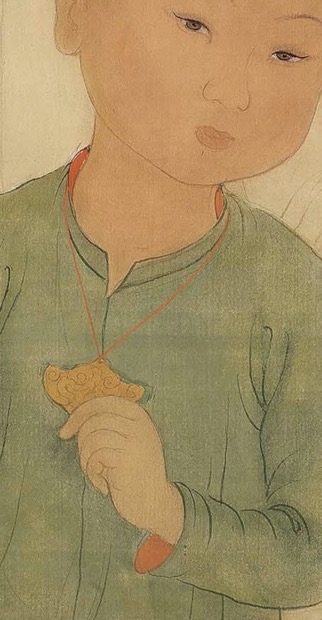
In fact, on his left hand, he holds up a Kim Khánh 金磬, which is attached to his neck by a thin cord. Under the Nguyens, since probably Gia Long (1802-1820), the emperors of Vietnam awarded this decoration to their mandarins or deserving senior officials. It con sists of a golden plaque in the shape of a traditional Vietnamese gong, and is decorated with various Chinese characters and symbols such as dragons (and the sacred pearl), Fô dogs, turtles or phoenixes, depending on the recipient’s precise rank.
Why is this Kim Khánh being brandished by the young child? Has the recipient, the head of the family, passed away?
What’s really going on behind closed doors?
Does the maternal passivity we sense at first glance, and the group’s glances into the distance, reflect a disarray we’re fighting together?
A very Western question? No, very modern.
For André Comte-Sponville (Dictionnaire Philosophique, 2 éd Paris, 2021),
“To be modern (…) is to place reason higher than faith or revelation, individual freedom higher than obedience, progress higher than tradition – and the future, especially from the 19th century onwards, higher than the present or eternity”.
From the same source: “The essence of a being is its power to exist; its existence is its essence in act”.
For a painter, the supreme act is to paint, and this “mother and children”, figurative if ever there was one, bears witness to a fracturing world where all codes are diluted. It’s the end of all political, economic, social and cultural frontiers. Underneath the painting, which could be as unctuous as a 17th-century French powdered marquis, a witness, sometimes in spite of himself, to the cataclysms that are piling up.
With Mai Thu, as with Le Pho or Vu Cao Dam, but also with Nguyen Phan Chanh or Nguyen Gia Tri, it’s people, not pines or rocks, that “mean”.
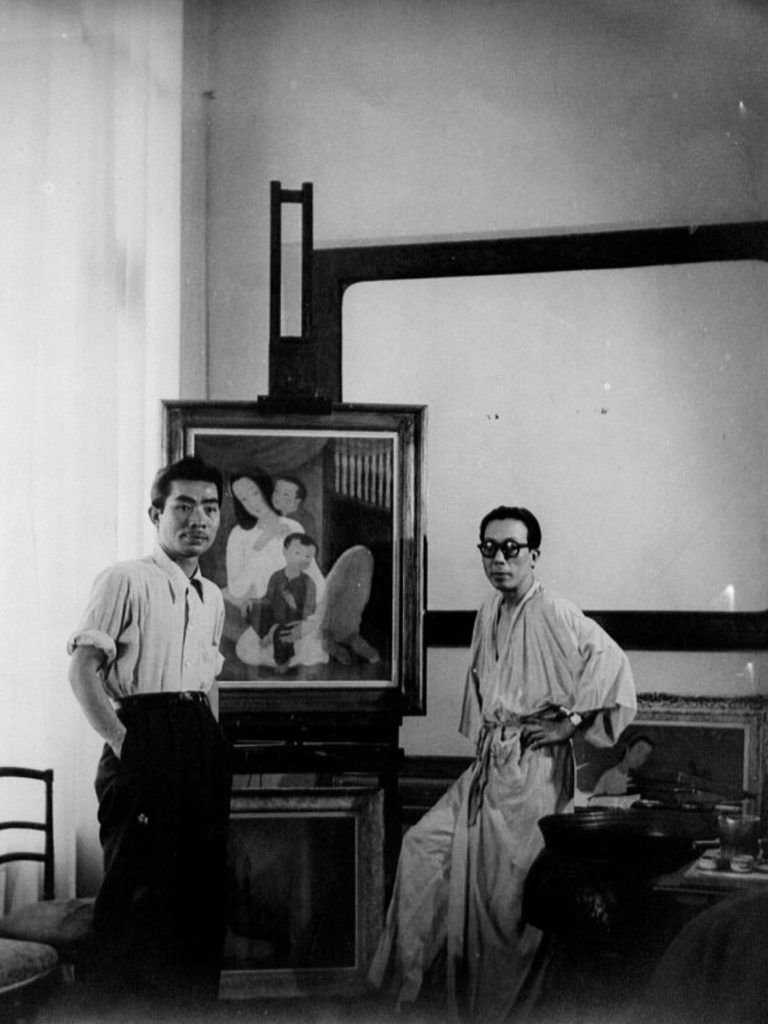
For them, it’s important to describe an immediate world, not that world where “vital breaths (are) supposed to link all beings and their actions in a chou-liu (“universal circulation”) involving incessant internal transformations…” (François Cheng, ibid, p169)
No, here it’s a world, frozen because it’s stupefied, that’s expressing itself.
It’s a healthy and cruel stupefaction, because the artist
of Vietnam (we salute the nuance of the term, different from “Vietnamese artist”) learned in the twentieth century that his world, the reality accessible to him, was disappearing… with him.
With all the taboos. This is the “delicate manifestation”.
Jean-François Hubert
